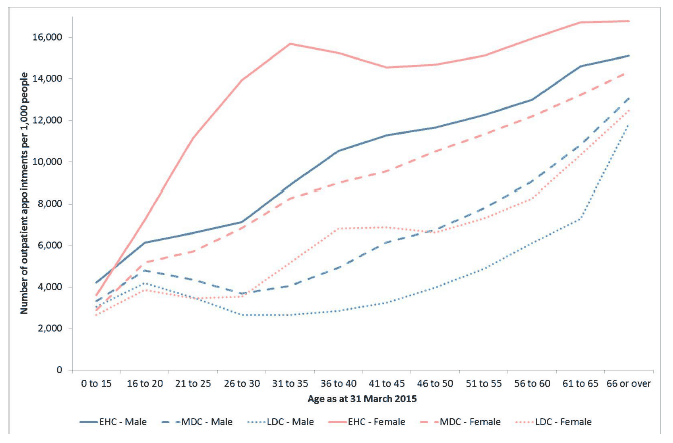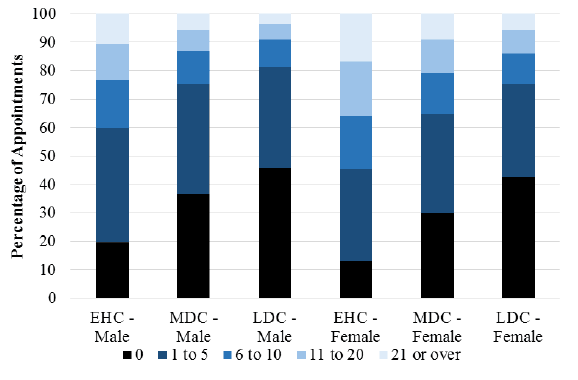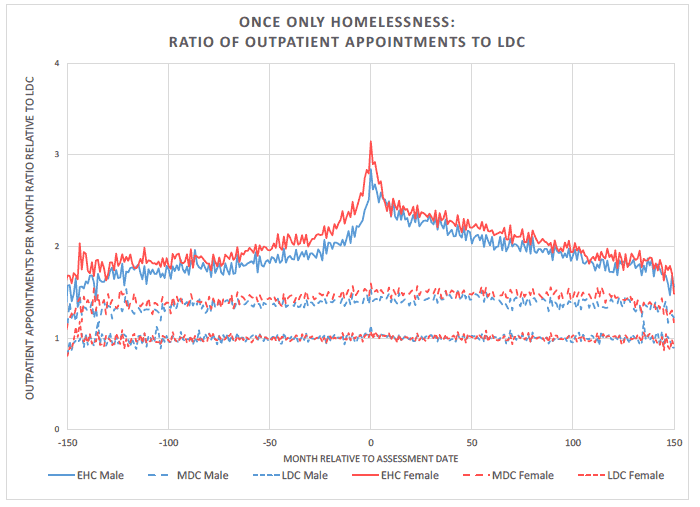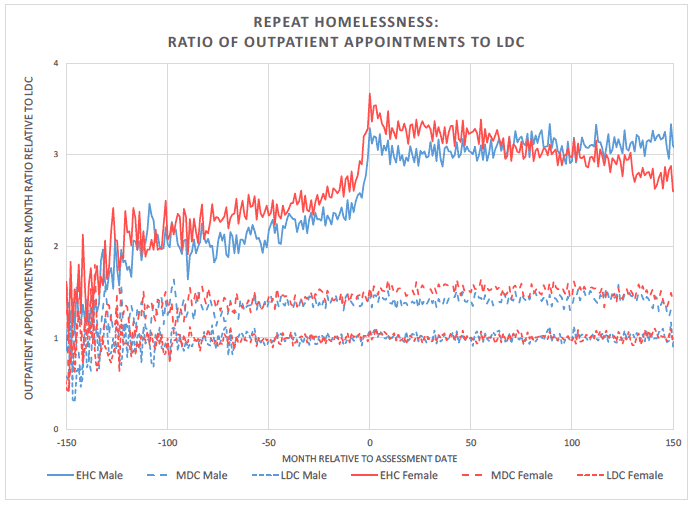Health and homelessness in Scotland: research
Study exploring the relationship between homelessness and health.
Chapter 5: Outpatients
There were 9 million outpatient appointments [40] over the time period 1 April 2002 to 31 March 2015 inclusive for the 1.3 million people in the study. For more information on the outpatient appointments ( SMR00) data see Section 2.3.5.
In this chapter we discuss the study cohorts, their outpatient activity and how this relates to homelessness. How this relates to deprivation and health needs is discussed in Chapter 11.
5.1 Comparative activity between the EHC and their controls
Accounting for one third of all people in the study, people in the EHC (Ever Homeless Cohort) accounted for 49% of outpatient appointments (21% male, 28% female). Outpatient appointments amongst the MDC (Non-homeless 20% Most Deprived Cohort) accounted for 30% of appointments during the period (13% male, 17% female). The LDC (Non-homeless 20% Least Deprived Cohort) accounted for 21% of appointments (9% male, 12% female).
Table 5.1: Number of people, number of appointments and the ratio of the number of appointments between EHC and MDC, and between EHC and LDC, by age and sex.
| Age (at 31 March 2015) | Male | Female | ||||||
|---|---|---|---|---|---|---|---|---|
| Number of people | Appointments | EHC : MDC | EHC : LDC | Number of people | Appointments | EHC : MDC | EHC : LDC | |
| 0 to 15 | 135,444 | 477,835 | 1.3 | 1.4 | 127,461 | 389,287 | 1.2 | 1.4 |
| 16 to 20 | 49,263 | 248,966 | 1.3 | 1.5 | 51,276 | 278,227 | 1.4 | 1.9 |
| 21 to 25 | 64,209 | 309,503 | 1.5 | 1.9 | 78,690 | 533,021 | 2.0 | 3.2 |
| 26 to 30 | 75,363 | 338,553 | 1.9 | 2.7 | 93,003 | 753,521 | 2.0 | 3.9 |
| 31 to 35 | 70,407 | 430,872 | 2.2 | 3.3 | 74,493 | 836,175 | 1.9 | 3.0 |
| 36 to 40 | 58,347 | 280,322 | 2.1 | 3.7 | 53,259 | 431,756 | 1.7 | 2.2 |
| 41 to 45 | 55,737 | 384,279 | 1.8 | 3.5 | 48,873 | 504,838 | 1.5 | 2.1 |
| 46 to 50 | 49,818 | 372,236 | 1.7 | 2.9 | 43,563 | 462,084 | 1.4 | 2.2 |
| 51 to 55 | 37,746 | 313,667 | 1.6 | 2.5 | 31,578 | 355,088 | 1.3 | 2.1 |
| 56 to 60 | 25,017 | 235,027 | 1.4 | 2.1 | 19,017 | 230,885 | 1.3 | 1.9 |
| 61 to 65 | 15,765 | 171,961 | 1.4 | 2.0 | 11,436 | 153,521 | 1.3 | 1.6 |
| 66 or over | 21,591 | 287,786 | 1.2 | 1.3 | 16,203 | 235,454 | 1.2 | 1.3 |
| All ages | 658,707 | 3,851,007 | 1.6 | 2.3 | 648,852 | 5,163,857 | 1.6 | 2.4 |
In order to see how outpatient appointments compare in the different cohorts, ratios of outpatient appointments were constructed for each age band and sex ( Table 5.1). The following points apply for both sexes:
The EHC have more outpatient activity
In total, the EHC has 60% more outpatient appointments than the MDC (1.6 times for males and females) and over double the number of outpatient appointments compared with LDC (2.3 times for males, 2.4 times for females).
For each age and sex breakdown, the EHC have more outpatient activity
Compared to the controls in the MDC or LDC, the ratio of appointments is always greater than one (minimum ratio is: 1.2, EHC : MDC for males at 66+ years, and for females at 0–15 and 66+).
EHC males aged 31–40 years have the most outpatient appointments compared with their controls
For males EHC : LDC peaks at 3.7 at 36–40 years, and EHC : MDC peaks at 2.2 at 31–35 years. The LDC outpatient appointment rate ( Figure 5.1) decreases from 16–20 to 26–40 years, while the EHC rate continues to increase with age. Thus the ratio between these increases over this range, to peak at 36–40 years. The MDC shows a trend similar to, but less pronounced than, the LDC. These differences in shape are what drives the variation in the ratios with age.
EHC females aged 26–30 years have the most outpatient appointments compared with their controls
For females EHC : LDC peaks at 3.9 at 26–30 years, and EHC : MDC peaks at 2.0 at 21–30 years. The MDC and LDC appointment rates generally increase with age. In contrast the EHC rate increases steeply to 31–35 years, and then decreases to 41–45 years. This produces a bulge in the appointment rate, similar to that observed in Chapter 4. The peak ratio is therefore at the end of the steep increase of the EHC.
Figure 5.1: Number of outpatient appointments per 1,000 people by age, sex and cohort.

5.2 Distribution of the number of appointments
The previous section found that, on average, people in the EHC had more outpatient appointments than their controls. This section explores whether this is due to a higher proportion of the EHC having outpatient appointments, or a higher proportion of the EHC who had appointments having many outpatient appointments, or both ( Figure 5.2). The following points apply for both sexes:
More of the EHC had at least one outpatient appointment
A higher proportion of the EHC (80% males, 87% females) had at least one outpatient appointment than the MDC (63% males, 70% females) and LDC (54% males, 58% females) over the study period.
More of the EHC had many outpatient appointments
A higher proportion of the EHC (10% males, 17% females) had 21 or more outpatient appointments than the MDC (6% males, 9% females) and LDC (4% males, 6% females) over the study period. Even among people who had at least one outpatient appointment, a notably higher proportion of the EHC had many appointments than the MDC and LDC.
Figure 5.2: Proportion of cohort in total number of appointment bands

5.3 Appointments by attendance type
Outpatient appointments are categorised as either: patient was seen, patient attended but was not seen (could not wait, CNW), and patient did not attend and gave no prior warning (did not attend, DNA). The two categories of CNW and DNA both result in the patient not being seen. They can be combined to create a new category – patient was not seen.
Table 5.2: Number of outpatient appointments by clinic attendance by cohort, per 1,000 people in cohort by sex.
| Clinic attendance per 1,000 people | Male | Female | ||||
|---|---|---|---|---|---|---|
| EHC | MDC | LDC | EHC | MDC | LDC | |
| Patient was seen | 6,119 | 4,284 | 3,366 | 9,112 | 6,146 | 4,521 |
| Patient was not seen | 2,395 | 975 | 400 | 2,580 | 1,104 | 412 |
|
18 | 6 | 2 | 17 | 6 | 2 |
|
2,376 | 969 | 398 | 2,563 | 1,098 | 410 |
| Total | 8,514 | 5,259 | 3,766 | 11,692 | 7,250 | 4,933 |
| Proportion of total appointments 'not seen' | 28% | 19% | 11% | 22% | 15% | 8% |
The proportion appointments that resulted in people not being seen was calculated for each cohort ( Table 5.2). The following apply for both sexes:
A greater proportion of appointments for EHC resulted in people not being seen.
The proportion that were not seen was higher for the EHC (28% males, 22% females) than in the MDC (19% males, 15% females), and the LDC (11% males, 8% females).
Could Not Wait was the highest for the EHC
The proportion that CNW was higher for the EHC (0.17%) than the MDC (0.10%) and the LDC (0.05%).
One might suspect that the reason the proportion of patients not being seen was higher for the EHC is that homeless people may not have received or been aware of a reminder for the appointment, or that they were not able to get to the hospital. This would explain the greater proportion of DNA appointments, but not the relatively higher rate of Could Not Wait appointments. In addition, the higher rate of outpatient appointments may also partly be driven by the re-booking of missed appointments.
5.4 Outpatient appointments for Once-Only and Repeat Homelessness
This section explores differences in outpatient appointment ratios between those people in that have only been assessed as homeless once ( Figure 5.3) (Once-only EHC), and those who have been assessed as homeless on multiple occasions, referred to as repeat homelessness (repeat EHC) ( Figure 5.4). More information on repeat homelessness is available in section 2.1.3.
The shape of the graph for the EHC is markedly different from the MDC. The following points generally apply for both sexes:
Even several years before the date of first assessment, the EHC ratio is higher
People who go on to become homeless (once-only and repeat) appear to have more outpatient appointments, years prior to their first homeless assessment.
EHC outpatient appointments increase towards assessment date
From around four years prior to (for Repeat EHC, two years for Once-only EHC), to a few months before, the date of first homelessness assessment, EHC outpatient appointments increase relative to LDC outpatient appointments.
There is a clear peak for Once-only EHC outpatient appointments around assessment date
In the months immediately prior to the date of first homelessness assessment, Once-only EHC outpatient appointments increase (peak value of around three).
Once-only EHC outpatient appointments gradually decline to the earlier level
By around eight years after the homelessness assessment the Once-only EHC outpatient appointments ratios declines to around the value four years before the date of first assessment.
Repeat EHC ratios increase around assessment date and gradually decrease for females
While there is not a substantial peak among the Repeat EHC, there is a notable level-shift around this time. Among males this higher ratio is maintained for the duration of the study period. Among females this gradually decreases, but still remains above the prior level.
If differences in outpatient appointments between the cohorts were driven by factors associated with deprivation alone, then the shape of the EHC line would be similar to that of the MDC. Therefore, it appears that homelessness has a relationship with outpatient appointments. In general the findings are similar to that for A&E attendances and acute admissions, so the possible mechanisms raised there are also relevant here.
Figure 5.3: Ratio of appointments per month (relative to assessment date) for people with one homelessness assessment for each cohort to the appointments among the LDC by sex.

Figure 5.4: Ratio of appointments per month (relative to assessment date) for people with repeat homelessness assessment for each cohort to the appointments among the LDC by sex.

5.5 Summary
The EHC have more outpatient appointments than the control cohorts. This is true for each age and sex breakdown, and is greatest among males aged 31–40 years and females aged 26–30 years. This is due to more of the EHC having at least one outpatient appointment, and among those who do have appointments, more of the EHC have multiple outpatient appointments. A greater proportion of outpatient appointments for people in the EHC resulted in people not being seen, primarily because the person did not attend. The proportion of outpatient appointments classed as could not wait were also much higher for the EHC. Missed appointments only partly explain why the EHC have more outpatient appointments.
It is clear that there is evidence to support each of the four research questions:
- A gradually worsening condition prior to the date of first assessment that results in excess outpatient appointments, before homelessness occurs. EHC outpatient appointments increase towards the first assessment date.
- Also for some people the (first) homelessness episode is associated with some crisis with a health activity component, as observed by an outpatient appointments peak around that time. There is a clear peak for Once-only EHC outpatient appointments around assessment date, and a level-shift for repeat homeless people.
- Ratios after assessment date gradually decline to the earlier level for the Once-only EHC. These ratios gradually decline for repeat females - yet not to earlier levels, and remain high for repeat males.
- Lastly, people who go on to become homeless appear to have more outpatient appointments, even several years prior to their first homeless assessment.
Contact
There is a problem
Thanks for your feedback